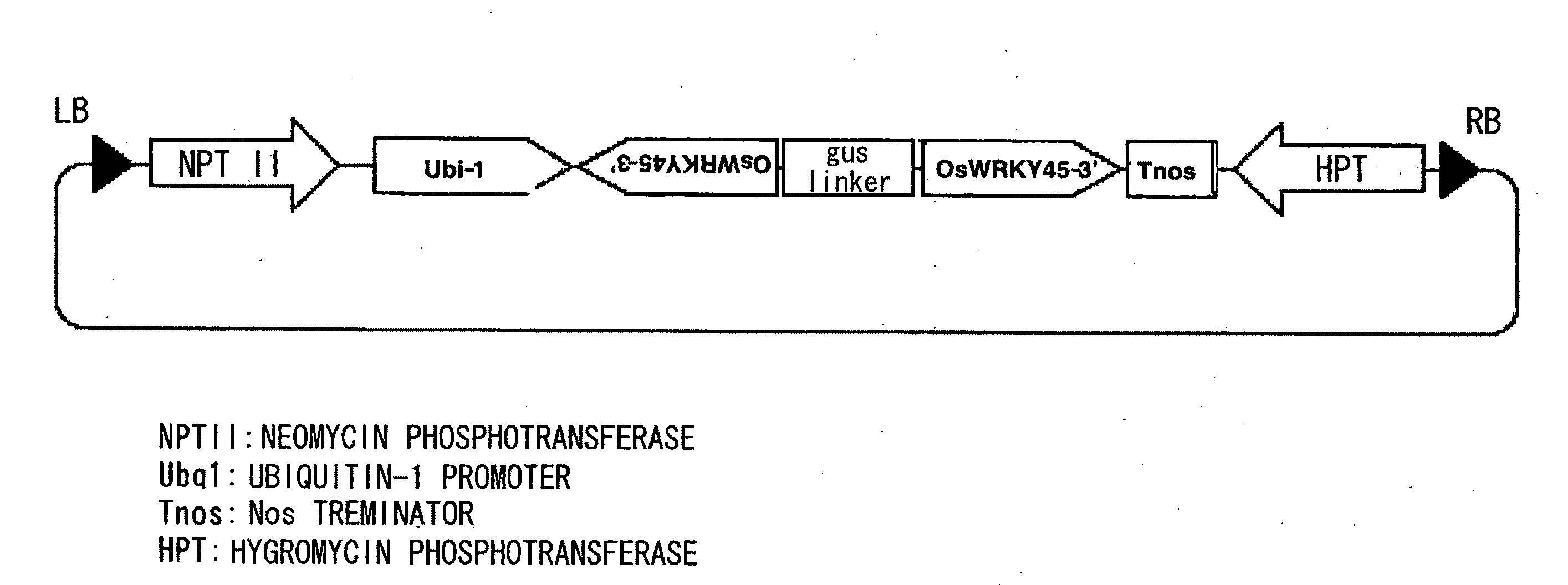Disease resistance in plants by introducing transcription factor gene
- Summary
- Abstract
- Description
- Claims
- Application Information
AI Technical Summary
Benefits of technology
Problems solved by technology
Method used
Image
Examples
example 1
Detection of a Transcription Factor Gene Inducibly Expressed by BTH
[0080]In order to detect a transcription factor gene inducibly expressed by BTH, rice seedlings (3.5-leaf stage) on day 10 after seeding were treated with 0.5 mM BTH (in 0.01% Tween 20 / 0.5% acetone), and the RNAs prepared over time (12, 24, 72, and 120 hours after the treatment) from BTH-treated and mock-treated rice leaves were subjected to DNA microarray analysis with the rice 22K array (Agilent). As a result, a WRKY transcription factor gene (OsWRKY45, AK066255; SEQ ID NOs: 1 and 2) that is inducibly expressed by BTH treatment was found. Northern blot analysis showed that OsWRKY45 expression was induced within 3 hours after BTH treatment (FIG. 1).
example 2
Preparation of High Expression Vector for OsWRKY45 Gene
[0081]A vector for constitutively expressing the OsWRKY45 gene in plants was prepared by the following procedures. First, pUCAP / 35S-NT (Kapoor et al., 2002) was cleaved with HindIII-BamHI, and an HindIII-BamHI fragment containing the corn Ubi-1 promoter derived from pAHC27 (Christensen and Quail, 1996) was inserted. Next, the obtained plasmid was cleaved at the BamHI-SacI sites between the Ubi-1 promoter and Nos terminator, and a complementary oligonucleotide (in which the top strand: 5′-GATCTGGCCAAATCGGCCGGTACCGGATCCGCGGCCGCGAGTC (SEQ ID NO: 3) and the bottom strand: CGCGGCCGCGGATCCGGTACCGGCCGATTTGGCCA (SEQ ID NO: 4) were annealed) was inserted to prepare pUCAP / Ubi-NT that includes both SfiI and BamHI sites between the Ubi-1 promoter and Nos terminator. pUCAP / Ubi-NT was cleaved with SfiI-BamHI, and an SfiI-BamHI fragment containing the full-length cDNA of the OsWRKY45 gene was inserted. Finally, this plasmid was cleaved with Hi...
example 3
Introduction of a High Expression Vector for OsWRKY45 Gene into Agrobacterium tumefaciens EHA101 Strain
[0082]In order to introduce the plasmid pZH-Ubi-W45-NT into Agrobacterium tumefaciens EHA101 strain, the strain was cultured with shaking in 5 ml of YEB medium (0.1% yeast extract, 0.5% meet extract, 0.5% peptone, 0.5% sucrose, and 0.05% MgSO4·7H2O) at 30° C. overnight. Next, 5 ml of the above culture was added to 200 ml of YEB medium in a 1-liter flask, and the mixture was further cultured at 30° C. for 5 to 6 hours. The cells were collected by centrifugation (at 4000 rpm for 5 min) and suspended in 100 ml of 10 mM Tris-HCl (pH 8.0). The suspension was centrifuged again, and the obtained cells were suspended in 2 ml of YEB medium. 200 μl of this suspension and 100 μl of a DNA solution containing 0.5 μg of pBE7133H-Thionin were mixed in a microcentrifuge tube, and the mixture was frozen in a dry ice / ethanol bath (for 5 min). The frozen mixture was then thawed in a 37° C. warm bath ...
PUM
| Property | Measurement | Unit |
|---|---|---|
| Electrical resistance | aaaaa | aaaaa |
Abstract
Description
Claims
Application Information
 Login to View More
Login to View More - R&D
- Intellectual Property
- Life Sciences
- Materials
- Tech Scout
- Unparalleled Data Quality
- Higher Quality Content
- 60% Fewer Hallucinations
Browse by: Latest US Patents, China's latest patents, Technical Efficacy Thesaurus, Application Domain, Technology Topic, Popular Technical Reports.
© 2025 PatSnap. All rights reserved.Legal|Privacy policy|Modern Slavery Act Transparency Statement|Sitemap|About US| Contact US: help@patsnap.com



